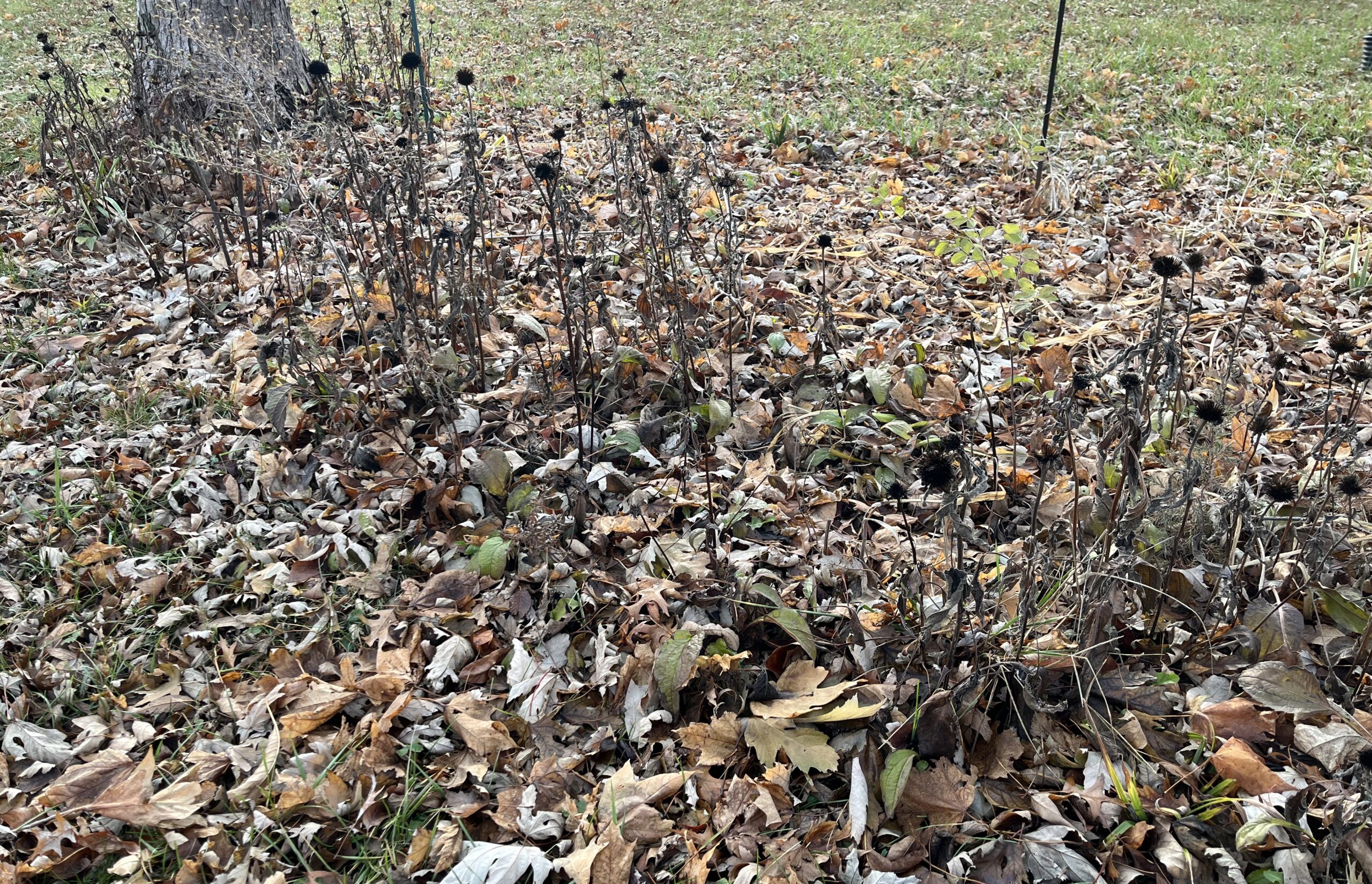The Hort Report: Now is time to plan for next year, and the importance of using leaves as mulch

Hopefully everyone enjoyed a great Thanksgivings Day with family and friends. This is a time of year when we need to be thankful for everything we have in this world. If you are like me, you overate and need to lose weight.
The snow we had the other day has really helped the soil get much needed moisture. It helped seal the soil in and around the plant roots of various perennial flowers, along with perennial vegetables.
Even with the snow melting off within 12 to 24 hours, this will be a big help in helping these plants and vegetables survive the winter. Now we know winter is here.
We have seen normal type weather in the past few weeks for this time of year. We have had enough cold nights so we can finish cleaning the perennial flowerbeds and garden, as well as prune bushes, shrubs and trees.
As you clean your garden and flowerbeds and doing other outside work in the coming days, you should write what you need to change for the 2024 growing season.
I tell people in my South Shelby adult vo-ag horticulture class that this is an important part of your planning for the next growing season. If you fail to plan, you plan to fail.
I’m working on cleaning the garden or flowerbeds. This is the best time to be doing this as it is fresh in your mind. If you wait, you may forget something and be disappointed next year.
Examples are:
- Get the first planting of greenbeans planted by the second week of April.
- Plant another planting of greenbeans a couple of weeks later.
- Get all my tomato and pepper seed planted sooner in 2024, so I can get the transplants ready to plant in the garden by the last week of March.
The most important thing you should be doing is to draw out your current garden. You will want to move some of your vegetables into a different place for 2024 than where they were in 2023. You may need to plan on increasing or decreasing how much of each type of vegetables you are going to be planting in 2024.
Here are a few questions to ask yourself.
- Did you and your family, friends and neighbors use all the produce from your garden?
- Did you throw some of it away, or did it rot in the garden?
- Did you sell some of it?
- Did you give it to a local food pantry?
Once you have the answers to these questions, you should decide if you will be increasing or decreasing the size of the garden. These are questions you can be working on now.
In the coming days, you should be getting seed catalogs in the mail. Start to make plans as to what vegetables you want to grow in 2024. By having an idea of what kinds of vegetables everyone enjoyed or didn’t enjoy, you should have a list to use as you start to plan on what seed to buy.
This is something that you can work on now until early spring, when you should have a list made of what you will be growing, along where each vegetable will be growing in your garden.
I previously talked about using leaves as mulch and when to be mulching. Since we have had snow and several days of freezing or below temperatures, you can begin to mulch your perennial flowers, vegetable plants and other places in your yard.
The best mulch to use this time of year is leaves, which is often called the fall’s most abundant crop. Pound for pound, leaves can have as much as two times the amount of mineral content as manure.
Leaves used as mulch are a very cheap form of organic matter. Here’s why:
- Leaf humus can help break up the clay in our soils.
- Leaves help feed the earthworms and other micro-organisms in our soils.
- Leaves help increase the moisture content of dry sandy soils.
- Leaves look better in flowerbeds as mulch than other mulches.
- They work great in the compost pile to help balance the nitrogen levels.
- They are a great way to help protect and insulate tender plants from the cold winter weather.
I realize the snow has caused the leaves to become wet and hard to move, but you can see why you should be using leaves as mulch.
If you can’t use the leaves now, put them into a compost pile to let them start to decompose. This is what we do with the leaves at my daughter Hillary’s house. The leaves we piled up last year and the year before were used this year in our garden and raised beds this year. I got them down as mulch in the spring to control weeds.
You can use leaves in many ways around your garden, flowerbeds and yard. This gets more good uses of them instead of just burning them. If you don’t want to use them in the ways I talked about before, then mow them and let them stay on the grass to be used as organic matter for the new year.
I realize with the snow we have had the leaves might be pushed down into the grass, but we should have a few more days when you can mow your yard. I know I still need to mow our yard one more time this year. So if you do nothing else, mow your leaves. Don’t burn them. That is a waste.
You still have time to think about tilling your garden. I like to till our garden in the fall, then add some type of organic matter, then let it lay on top of the newly tilled garden soil.
The winter weather will break down organic matter, allowing it to be in the garden soil more in the coming year. If you do this every year over several years, you will have built a great mix of topsoil for your garden vegetables to grow in.
When cleaning up your flowerbeds, leave many perennial flower heads alone. In the past few years, we have been leaving our cone flower and shasta daisy flower seed heads alone. This will help feed the birds and other wildlife during the cold winter months. We also leave a few annual flower seed heads too.
We will then start to cut back all other perennial and annual plants, letting them lay on top of the soil in the flowerbeds to form a protective layer of mulch. We sometimes will put the grass and leaf clippings from mowing the yard on top of the other clippings from the flowers in the flowerbeds to create a thick mulch.
With the coming winter will be many different types of insects, birds and other wildlife that need a place to stay. Once the flowerbeds are cleaned up from the 2023 growing season, you will be providing a winter place to survive and be ready to reproduce and grow in 2024.
We have had a snow and several days of cold days and nights, but more end-of-the-year mowing may need to be done. We will mow the leaves and tall grass around our garden. I know it’s late in the year, but I wanted to wait until all the leaves have fallen.
Now is the time to make a list of what needs to be fixed, repaired or trashed. I will be talking more about what to do with the list once you get it done, but do it now when it is fresh on your mind.
As you clean your garden and flowerbeds, think about cleaning your power tools and hand tools. One of the big things my granddad Pete and dad Hiram always made sure we did was, after using any type of power tool or hand tool, to clean them and oil or grease them. When we would go to use them again, they are ready to go.
It also was a good time to check to see if any repairs were needed on anything. I know it’s easier to put something away once you are done with the project or job. I know I have done this a few times when I am running late or when it was getting dark and I am tired. But as soon as I could, I would clean up the tools, checking them over and putting them away. Doing this will help you remember where you leave something.
In the coming weeks I will be talking more about your garden and flowerbed plans, when and where you can get seed, fertilizer, tools and other items to make 2024 a better growing season than 2023. Hopefully we will have a better growing season with timely rains that will help everything grow better.
I appreciate all your questions in the past and look forward to them in the coming days. I always want to learn more, and you asking me questions will help me be a better person and teacher.
Call me at 573-588-2040 at Shelby County Implement in Shelbina, or just come out to see me. I also enjoy people stopping in. You can email me at sci63468@hotmail.com
Hope you enjoyed the great fellowship and food at Thanksgiving.

Pat Greenwell is the owner of Shelby County Implement in Shelbina, Mo. He was a high school agriculture teacher for 11 years. He has taught adult vocational agriculture since 1987. He also is a research assistant at the Truman State University Ag Department Farm.
Miss Clipping Out Stories to Save for Later?
Click the Purchase Story button below to order a print of this story. We will print it for you on matte photo paper to keep forever.

